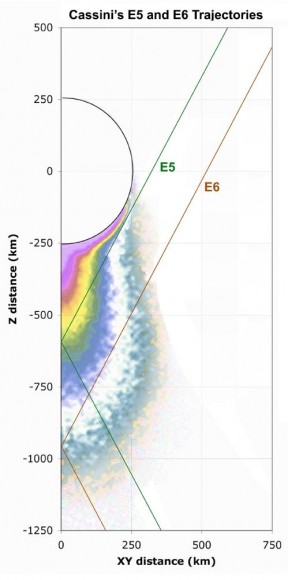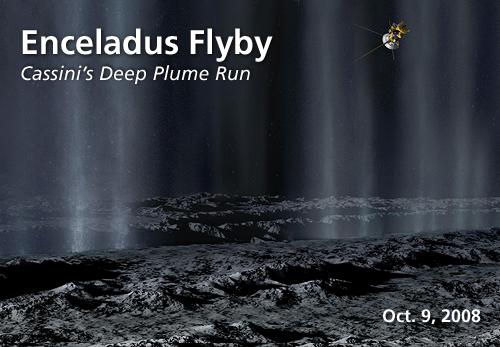[/caption]
The Cassini spacecraft will make two close passes of Saturn’s geyser-spewing moon Enceladus this month. The first one on October 9 is the closest flyby yet of any moon of Saturn, at a white-knuckle distance of only 25 kilometers (16 miles) from the surface. The not-quite-as-scary Halloween flyby on Oct. 31 will be farther out, at 196 kilometers (122 miles). The focus of the Oct. 9 is the plume of the moon’s geyser, and the spacecraft’s fields and particles instruments will venture deeper into the plume than ever before, directly sampling the particles and gases. Scientists are intrigued by the possibility that liquid water, perhaps even an ocean, may exist beneath the surface of Enceladus. Trace amounts of organics have also been detected, raising tantalizing possibilities about the moon’s habitability.
While Cassini’s cameras and other optical instruments were the focus of an earlier flyby in August, this time the emphasis will be on the composition of the plume rather than imaging the surface.
“We know that Enceladus produces a few hundred kilograms per second of gas and dust and that this material is mainly water vapor and water ice,” said Tamas Gambosi, Cassini scientist at the University of Michigan, Ann Arbor. “The water vapor and the evaporation from the ice grains contribute most of the mass found in Saturn’s magnetosphere.
“One of the overarching scientific puzzles we are trying to understand is what happens to the gas and dust released from Enceladus, including how some of the gas is transformed to ionized plasma and is disseminated throughout the magnetosphere,” said Gambosi.

On Oct. 31, the cameras and other optical remote sensing instruments will be front and center, imaging the fractures that slash across the moon’s south polar region like stripes on a tiger.
These two flybys might augment findings from the most recent Enceladus flyby, which hint at possible changes associated with the icy moon. Cassini’s Aug. 11 encounter with Enceladus showed temperatures over one of the tiger-stripe fractures were lower than those measured in earlier flybys. The fracture, called Damascus Sulcus, was about 160 to 167 Kelvin (minus 171 to minus 159 degrees Fahrenheit), below the 180 Kelvin (minus 136 degrees Fahrenheit) reported from a flyby in March of this year.
“We don’t know yet if this is due to a real cooling of this tiger stripe, or to the fact that we were looking much closer, at a relatively small area, and might have missed the warmest spot,” said John Spencer, Cassini scientist on the composite infrared spectrometer, at the Southwest Research Institute, Boulder, Colo.
Results from Cassini’s magnetometer instrument during the August flyby suggest a difference in the intensity of the plume compared to earlier encounters. Information from the next two flybys will help scientists understand these observations.
Four more Enceladus flybys are planned in the next two years, bringing the total number to seven during Cassini’s extended mission, called the Cassini Equinox Mission.
The Enceladus geysers were discovered by Cassini in 2005. Since then, scientists have been intrigued about what powers them, because the moon is so tiny, roughly the width of Arizona at only 500 kilometers (310 miles) in diameter.
Source: Cassini Press Release


I think this is the most daring space-feat attempted since Voyager I’s trip through Saturns rings. Good Luck Cassini!
the cassini mission makes up for decades of NASA mediocrity
I love your blog! Read it every day. I just have one question, are you a scientist/astronomer or are you like me, just write about astronomy?
have a nice day // Assi from sweden
“this time the emphasis will be on the composition of the plume rather than imaging the surface.”
I hope they try to get at least one super close up shot inside one of the tiger stripes. Imagine the resolution from only 15.5 miles! :-0
Good stuff. I think Enceladus is the most exciting target for Cassini at the moment. Can’t wait to see what the data yields…
“# neil Says:
October 8th, 2008 at 1:53 pm
“the cassini mission makes up for decades of NASA mediocrity”
Possibly warranted to a certain extent, but pretty harsh! What about Pathfinder, Galileo, Spirit & Opportunity, the 4 Great Observatories, MRO, Ulysses etc. I know they are fewer and further between than would be good, but…
I guess things were a bit dry before that though. Here’s to the future…
Reasonably interesting article. I am more impressed with the precision guidance of the ‘craft that what it might find there.
I do have a bone to pick, though… This article sloppily quotes;
“Trace amounts of organics have also been detected, raising tantalizing possibilities about the moon’s habitability.”
By “organics”, I assume you mean organic chemicals or do you mean organic material – which has a completely different meaning? If you mean organic chemicals, these are not necessarily used, created, nor evidence of, biological processes. I.e. Formic acid, formaldehyde, or chloroform are all organic chemicals. Organic chemistry is preferably defined by have some carbon atoms in there structure.
The use of “organic” with living organisms comes from the now abandoned idea of vitalism (founded in 1820’s) that attributed a special force to life that alone could create organic substances.
I.e. The theory that the origin and phenomena of life are dependent on a force or principle as specifically distinct from purely chemical or physical forces.
As a broader comment many authors and bloggers within this site, and in general media, seem to have continuing problems distinguishing chemistry (specially organic chemistry) and biology. Whilst chemical reactions might be a fundamental aspect of biology, they are not exclusively indicating life or a biological processes. Also this current popularist obsession in wanting to find living or historical life forms away from the Earth has generated almost a border-line quasi-scientific approach to the evidence of biology. Often, statements such as this one I’m discussing here are only written to promote some immediate response to the reader – mainly to make them read the article to its end.
The fact Enceladus might have liquid water and even traces of organic compounds, as you say, is interesting. However, then going on to the statement that there are; “tantalizing possibilities about the moon’s habitability” has no basis in fact nor evidence. I.e. You can still have liquid water, organic compounds or a some liquid solution containing both, and still have a sterile environment completely devoid of any life.
The control of the technology is superlative.
The interpretation of some of the results is questionable. Expect anomalously high temperatures to be found at the “plume” source sites, too high to be caused by gravitationally induced flexing. I suspect it’s a charged particle flux that is part of the larger Saturnian circuit that is causing the outflow.
Does anyone know how NASA keeps Cassini from colliding with objects in Saturn’s rings? OR is it just a low probability thing? I’d love to know.
Thump, Cassini is not crossing the rings right now. It’s orbiting further away from the planet than the rings. At least the larger rings, the ones that would be more risky. The only ring it has contact with is the E ring, and that one is quite tenuous.
It did cross them, though, at the time of orbit insertion. Then, the low probability thing kicked in.
Cassini positions herself so that much of her hardware is protected during every ring crossing….I don’t recall whether this is ‘nozzle first’ or ‘high gain antenna’ first.
Today’s pass through Enceladus’ plumes is with all systems running.
Finally got to rtead my emails. Cassini’s probably well under way with the ride ( or probably finished). Let’s see the photos.!!!
Thanks Jorge And Jerry!